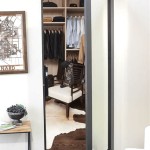How To Remove a Mirror Attached with Mastic
Removing a mirror attached to a wall with mastic adhesive can be a challenging task. Mastic, a strong, resilient adhesive, is designed to create a permanent bond, making mirror removal without damage to the mirror or the wall a delicate process. Understanding the nature of mastic and employing the appropriate techniques are crucial for a successful and damage-free removal. This article will outline a step-by-step guide to safely and effectively remove a mirror adhered with mastic, covering preparation, execution, and post-removal cleanup.
Prior to commencing the removal process, it is essential to assess the situation. Determining the type of wall (drywall, plaster, concrete) and the approximate amount of mastic used will greatly influence the chosen removal method. Moreover, ensure adequate ventilation in the work area to minimize exposure to dust and any potential fumes from solvents. Protecting the surrounding area is also paramount. Cover the floor with drop cloths or plastic sheeting to prevent debris, adhesive residue, and potential damage from falling mirror pieces. Gather the necessary tools and safety equipment before proceeding.
Preparation: Safety First and Gathering Materials
The safety of the individual performing the removal should be the foremost consideration. Eye protection, such as safety glasses or goggles, is essential to protect against flying debris and potential chemical splashes. Wearing gloves will safeguard hands from sharp edges of broken glass and contact with solvents or adhesive removers. A dust mask or respirator is recommended to prevent inhalation of dust particles, especially when working with drywall or plaster walls. Consider wearing long sleeves and pants for added protection.
The following tools and materials will be necessary for successful mirror removal:
- Safety Glasses or Goggles
- Gloves
- Dust Mask or Respirator
- Drop Cloths or Plastic Sheeting
- Putty Knife or Scraper (various sizes, including thin, flexible options)
- Piano Wire or Picture Hanging Wire
- WD-40 or Mastic Remover Solvent (specifically designed for construction adhesives)
- Heat Gun or Hair Dryer (optional, for softening mastic)
- Hammer (optional, for tapping putty knife)
- Utility Knife
- Painter's Tape
- Shims (plastic or wood)
- Paper Towels or Rags
- Cleaning Supplies (for removing adhesive residue)
- Trash Bags
Having all these materials readily available will streamline the removal process and minimize potential delays.
Execution: Employing the Right Removal Technique
There are several techniques for removing a mirror attached with mastic. The most appropriate method will depend on the mirror's size, the amount of mastic used, and the type of wall to which it is attached. The following are common and effective methods that can be used individually or in combination.
1. The Piano Wire/Picture Hanging Wire Method: This method is generally preferred as it minimizes the risk of breaking the mirror. First, carefully insert a thin putty knife behind the mirror at one of the corners. The goal is to create a small gap without applying excessive force that could shatter the glass. Once a small gap exists, thread the piano wire or picture hanging wire behind the mirror. Employ a sawing motion, pulling the wire back and forth, to gradually sever the mastic adhesive. Work slowly and methodically, moving the wire along the back of the mirror. It may be helpful to have a second person assist in supporting the mirror as the adhesive is cut. If the wire encounters significant resistance, apply WD-40 or a mastic remover solvent into the gap to help soften the adhesive. Continue the sawing motion until the mirror is completely detached. This method is less likely to damage both the mirror and the wall.
2. The Putty Knife/Scraper Method: This method requires patience and careful application of force. Begin by using a utility knife to score around the perimeter of the mirror where it meets the wall. This helps prevent the paint or wallpaper from tearing away with the mirror. Using a flexible putty knife or scraper, carefully insert it behind the mirror at an edge or corner. Gently tap the handle of the putty knife with a hammer to help it penetrate the mastic. Work slowly, applying steady pressure. Avoid using excessive force, which could break the mirror or damage the wall. As the putty knife separates the mastic, insert shims behind the mirror to maintain the gap and prevent the adhesive from re-bonding. Apply WD-40 or a mastic remover solvent into the gaps to soften the adhesive. Continue working around the perimeter of the mirror until it is completely detached. This method carries a higher risk of breaking the mirror if not done carefully.
3. The Heat Gun/Hair Dryer Method: This method can be used to soften the mastic adhesive, making it easier to separate the mirror from the wall. Use a heat gun or hair dryer on a low setting and direct the heat towards the edges and back of the mirror. Avoid overheating the mirror, as this could cause it to crack. As the mastic softens, carefully insert a putty knife or scraper behind the mirror and begin separating it from the wall. Combine this method with either the piano wire or putty knife method for optimal results. This method is most effective when the mastic is relatively thin or has not been applied excessively.
Regardless of the chosen method, it is crucial to proceed with caution and patience. Rushing the process can result in damage to the mirror, the wall, or both. If the mirror feels particularly resistant, do not force it. Instead, apply more solvent, heat, or try a different approach.
Post-Removal: Cleanup and Wall Repair
Once the mirror has been successfully removed, the focus shifts to cleaning up the remaining mastic residue on the wall. The type of wall surface (drywall, plaster, concrete) will dictate the appropriate cleanup methods.
Removing Mastic Residue: Start by scraping off as much of the mastic residue as possible using a putty knife or scraper. Be careful not to gouge or damage the wall surface. For stubborn residue, apply a mastic remover solvent according to the manufacturer's instructions. Allow the solvent to dwell on the mastic for the recommended time before attempting to scrape it off. Repeat this process as necessary until the majority of the residue is removed. For drywall, avoid excessive scraping, as this can damage the paper facing. For plaster walls, be mindful of potential chipping or cracking.
Wall Repair: After removing the mastic residue, the wall will likely require some repair. If the wall is drywall, fill any holes or indentations with drywall compound. Apply thin coats of compound, allowing each coat to dry completely before applying the next. Sand the compound smooth using fine-grit sandpaper. If the wall is plaster, use plaster patching compound to fill any cracks or holes. Follow the manufacturer's instructions for mixing and applying the compound. Sand the plaster smooth after it has dried completely. For both drywall and plaster walls, prime the repaired areas before painting. This will help ensure that the paint adheres properly and provides a uniform finish. Apply two coats of paint, allowing each coat to dry completely before applying the next. Match the paint color to the existing wall color for a seamless repair.
Disposal: Dispose of the removed mirror and mastic-covered debris properly. Check local regulations for disposal guidelines, as some areas may have specific requirements for disposing of glass and construction materials. Wrap the mirror in protective materials, such as cardboard or bubble wrap, to prevent injury during handling and disposal. Consider taking the mirror to a recycling center if available.
By following these detailed steps, removing a mirror attached with mastic can be accomplished safely and effectively, minimizing damage to both the mirror and the wall. Patience, careful execution, and the right tools are key to a successful outcome.

How To Remove A Mirror Glued The Wall With Mastic

How To Remove A Mirror Glued The Wall With Mastic

Remove Adhesive Black Mastic From Back Of Mirror

How To Remove A Mirror Glued The Wall With Mastic

How To Remove A Mirror Glued The Wall With Mastic

How To Remove Glued On Mirrors

Removing A Glued On Mirror From Wall

How To Remove A Mirror Glued The Wall Forbes Home

How To Remove A Wall Mirror 11 Steps With Pictures Wikihow

How To Hang A Frameless Mirror On The Wall With Pictures








